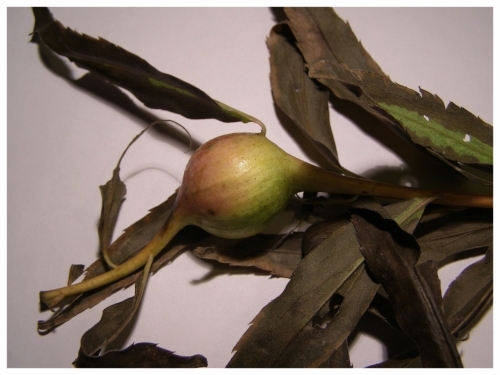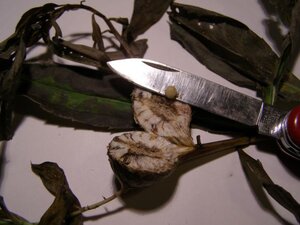

Curious about Galls?
It is a beautiful winter day. Our hike takes us right through a fallow field that just two months earlier was bordered by blazing yellow goldenrod. Now browned leaves droop from stems that sport an inflorescence of tiny fluffy seedheads. Something else catches the interest of my hiking companion. We step closer to find a ball-shaped swelling on the stem. “What is that?” she asks. Before I could answer, she points out another and another on nearby plants.
“This is a really interesting thing,” I begin. “It’s a gall.” Now I’m not sure how much she wants to hear about galls, but this manipulation of plants by animals just fascinates me, and I’ve studied and journaled and read about them over the years.
There are over 2,000 kinds of galls found on North American plants alone. Each is made by a particular species of insect or mite or even nematode. Some are caused by bacteria or fungus. Some galls are good – like the bacteria within the root gall of leguminous plants that assist with the uptake of nitrogen. Some cause agricultural headaches. Most are benign. The gall itself is plant material that the gall maker has caused to grow providing food and shelter for the occupant.
“This is a goldenrod ball gall,” I say. “It’s made by the goldenrod gall fly. No surprise there.” My hiking companion flashes me a quick smile before returning to examine the abnormality.
Gall makers are often very specific as to the type of plant they parasitize. In this case, the female Eurosta solidagnis lays an egg in the stem of goldenrod – in the spring. The egg hatches in ten days. The larva bores down into the stem, giving off hormones from its saliva, commandeering the plant’s growth pattern. Auxin and cytokinin are generated by the larva which stimulate cell elongation and cell division, thus encasing the larva in a ball of plant tissue. Here the larva stays for a full year. The larva can also counteract the plant’s natural defenses. Jasmonic acid – another hormone – is often produced by plants in response to an herbivore’s attack. It can trigger the release of compounds that prevent the offending insect from digesting the protein it seeks from the plant, making the feeding on that plant inefficient at best. But the larva prevents this defensive mechanism from occurring. After a year, the larva pupates within the gall, and a few weeks later the adult emerges. Adults live only two weeks “on the outside, ” but that’s enough time to mate and allow the females to lay eggs and begin the cycle all over again. I was less detailed for my companion.
Getting an idea, I asked my young companion to collect a gall, which she promptly did. “Do you want to see what’s inside?” There was no doubt that this interested her. I took out my Swiss army knife, knelt down to use a thigh as a table, and carefully sliced through the gall tissue right down the middle, stopping short of center. Prying the two pieces apart we found an inner chamber, inside of which was a tubby whitish little larva.
“Ewww,” she said. First reaction. Wait for it… I put the larva in my hand. In a couple seconds she said, “Let me see.” I knew her curiosity would trump revulsion. We examined the little fellow for a minute before her desire to find more galls diverted her attention. “Here’s another one,” the little girl said, “and another one! This one has a big hole in it,” she noted as she plucked the stem.
“Gee,” I said, taking it from her to examine, “Seems this larva got dug out of his gall. Who do you think would like to eat a tasty little morsel like that?
“Maybe a bird?”
“Sure, a chickadee or downy woodpecker would love that bit of extra protein. They’d sure have to work at it though.”
“Here’s a funny looking goldenrod,” she said, after having run ahead to examine more of the plants with which we are becoming so familiar. “Its got a bunch of tiny leaves on top.”
“You’ve got that right,” I say as I catch up to see what she is talking about. “This is another gall, called goldenrod bunch gall.”
This gall was made by a midge – Rhopalomyia solidaginis – that laid an egg in the meristematic tissue of the growing tip in the spring. This caused the plant to stop growing stem any higher, but it continued to grow leaves, making a tight cluster at the tip of the plant. According to my reading, higher susceptibility to bunch gall infestation is a heritable trait within populations of S. canadensis. This is worth further research on my part, since this might indicate some benefit to the plant.
“Let’s see who’s inside this one,” she said. I dutifully get out my knife.
“Okay, let me slice and then you can open it up.”
“Okay.” She watches intently as I slice through the middle part way down. “My turn.” I hand the gall over and she carefully pries the pieces apart. We peer into an empty chamber in the center of all the leaves. “Oh, I don’t see anything,” her voice conveying disappointment.
“Well, why do you think that is?” I prod. “What time of year is it now?”
“Oh, maybe it left already?”
“That’s a real good explanation.”
“Oh, but look there,” she exclaims, pointing with a finger that amid this small mess, could be pointing at anything. “It’s moving.”
“I see it.” I’m excited now too. “Looks like a spider.” These are my favorite arthropods.
“What’s he doing in there?”
“Probably thought it a nice place to spend a winter.” Bunch galls are commonly host to many other invertebrates besides the original inhabitant. Ecologists credit bunch galls to ecosystem diversity in fields.
Continuing on our hike, we soon found ourselves in a forest setting. Here my hiking partner found another natural thing that interested her. “Look what I found,” she presented me with an oak twig with a brown golf-ball-sized growth. “What is this?” she asked.
I’m pleased that she is finding things that I actually know. “That’s an oak apple gall.”
“Another gall?”
“Yup – this one is made by a wasp that laid her eggs at the base of a bud this past spring.”
“Look, it has a hole in it.”
“That’s where the adult came out of it this summer.”
“Let’s break it open and see what’s in there.” She’s getting the hang of these galls now. The brown, crispy gall broke open quite easily to reveal an almost hollow cavity with radiating fibers. These filaments are the remnants of vessels that transported nutrients and water to and from the larvae that once nestled in a chamber in the center.
“Look,” she exclaimed as she examined the interior of the gall more closely, “there’s a bug in here.” Sure enough, another little critter found the gall a convenient place to spend the winter, but its plans were foiled one again by our curiosity.
Further on, we started seeing some wild cherry trees along the trail. Our eyes were now keen on finding unusual growths. It is not long before my curious girl points out something unusual.
“Lookit that,” she points upward. “Looks like poop on that branch!” She’s rather amused. “Do you know what that is?” I recognize the young cherry tree right away and consider myself lucky today because this is another pathogen I recognize. There is a whole parade of tree knots and galls and burls caused by an assortment of pathogens such as bacteria, fungus, insects, and viruses.
“That looks like black knot,” I say coming closer to examine it. “Some people do call it poop fungus.”
“It’s not really poop?”
“No, it’s another type of gall caused by a fungus.”
Apiosporina morbosa is the causative agent of black knot. When its ascospores land on actively growing tissue or young twig of a species of Prunus, say a cherry or plum, the fungal strands penetrate into the cambium layer and stimulate the tree into making this tumor-like growth. Fungal hyphae cover the surface of the gall.
“Let’s do the tree a favor and cut it off, what do you say?” The little nods in agreement, anxious to get the interesting growth in hand to examine it more closely. I pull pruners out of my backpack (doesn’t everyone carry an extra set around?) and clip off the branch 10 inches below where the knot appears. The mycelium travel under the bark and I want to get it all. “Now, or in the winter is a good time to do this. In the spring when the weather turns warm and wet it sends its spores into the air to infect other trees,” I explain while I reach up and make the cut. I hand the branch with knot over to my curious hiker. She carefully examines its black bumps.
“It just crumbles,” she reports, as it breaks in her hand. “I don’t see any bugs.” I love that she is disappointed to not see bugs.
“No, it’s a fungus – like a mushroom,” I explain. “But bugs may come bore into old dried up portions.” Before she gets too carried away in breaking it apart, I pull out a plastic bag. “Let’s put all its pieces in here and cart it away just to make sure it doesn’t infect other cherry trees.” The fungus shouldn’t have viable ascospores at this time of year, but I want to be careful with it. I’ll take it home and burn it in my wood stove.
Our walk nearly over,
Winter is a good time to be on the lookout for galls of all sorts. You can find them on leaves, stems, buds, and roots of woody and herbaceous plants, agricultural and wild plants. Hopefully your curiosity will overtake your revulsion and take a peek inside to discover the inhabitant.